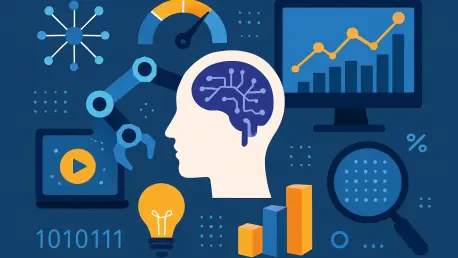In a world where data drives decisions at an unprecedented pace, staying updated on the latest advancements in analytics and data science is more critical than ever for businesses aiming to maintain a competitive edge. This week, remarkable strides have been made across the industry, with leading companies rolling out innovative solutions that promise to reshape how enterprises handle data, leverage artificial intelligence, and optimize workflows. From groundbreaking AI integrations to significant funding for data optimization technologies, the updates for the week of August 8 paint a picture of an industry in rapid evolution. These developments are not just incremental improvements but signal a broader shift toward accessibility, efficiency, and user empowerment in data-driven environments. As organizations grapple with increasingly complex data landscapes, the announcements from major players offer a glimpse into the tools and strategies that will define the future of analytics.
AI Innovations Transforming Enterprise Analytics
The integration of artificial intelligence into data analytics continues to be a game-changer, with recent announcements showcasing how AI is becoming a cornerstone of enterprise solutions. A notable highlight comes from Databricks, which has introduced OpenAI’s new open-weight models, such as gpt-oss 20B and 120B, across major cloud providers like AWS, Azure, and GCP. These models stand out for their advanced reasoning capabilities and support for tool use, providing businesses with greater control and customization compared to proprietary alternatives. This move reflects a growing trend toward accessible AI solutions that allow companies to tailor technologies to their specific needs, ultimately enhancing decision-making processes. As enterprises increasingly rely on both structured and unstructured data, such open models are poised to unlock deeper insights and foster innovation across various sectors.
Further emphasizing AI’s transformative impact, Qlik has shared compelling survey results that underline the role of generative AI tools in business analytics. By integrating platforms like ChatGPT through specialized connectors, Qlik is enabling organizations to boost productivity, improve the quality of insights, and accelerate workflows. This development points to a broader industry consensus that AI-driven tools are no longer optional but essential for maintaining a competitive edge. Unlike traditional analytics methods, these generative solutions facilitate a more dynamic interaction with data, allowing users to uncover patterns and trends with unprecedented speed. The focus on productivity also addresses a critical pain point for many businesses—how to derive actionable value from vast data reserves without overwhelming resources or personnel. Together, these advancements signal a pivotal moment where AI is not just augmenting but redefining the analytics landscape.
Seamless Integration and Data Optimization Efforts
Another key theme emerging this week is the push for seamless integration and efficiency within data platforms, addressing the complexities of modern enterprise environments. DataRobot’s recognition as an SAP-endorsed application in the SAP Store exemplifies this trend, as it embeds advanced AI and machine learning capabilities into a trusted enterprise ecosystem. This endorsement highlights how analytics solutions are increasingly designed to work within existing frameworks, ensuring smarter automation and minimal disruption to workflows. By bridging the gap between cutting-edge technology and established systems, such integrations enable businesses to adopt innovative tools without the burden of overhauling their infrastructure. This approach not only saves time and resources but also ensures that analytics capabilities are accessible to a wider range of users within an organization.
In parallel, Qbeast’s recent $7.6 million seed funding round marks a significant step forward in optimizing open Lakehouse analytics. Their multi-dimensional indexing technology promises to deliver up to six times faster queries and reduce compute costs by 70% for open data formats like Delta Lake and Iceberg. This addresses a pressing need for scalability and cost-efficiency in data management, particularly as organizations grapple with ever-growing datasets. By focusing on high-performance solutions, Qbeast is tackling the challenge of computational waste, which has long been a barrier to effective analytics at scale. Additionally, the collaboration between Redpanda and Databricks to provide unified streaming solutions further simplifies real-time analytics and AI integration. This partnership eliminates the complexities of legacy architectures, paving the way for modern data stacks that can handle the demands of instantaneous data processing with ease.
Enhancing User Experience in Data Exploration
User experience and accessibility are also taking center stage as companies strive to democratize data analytics for a broader audience. Microsoft’s update to Power BI, which rolls out the standalone Copilot experience by default starting next month, represents a significant leap in this direction. The “Chat with your data” feature allows users to interact with reports and datasets using natural language, making data exploration more intuitive and less reliant on technical expertise. This conversational approach breaks down barriers, enabling individuals across various roles to access insights from diverse data sources without needing to navigate complex interfaces. Such advancements are crucial for fostering a data-driven culture within organizations, where decision-making is informed by accessible and actionable information.
Beyond simplifying interactions, these user-centric updates aim to enhance cross-report exploration and expand the scope of traditional data views. By prioritizing natural language queries, Microsoft is aligning with a broader industry trend of lowering the technical threshold for analytics tools. This ensures that even non-specialists can derive meaningful conclusions from complex datasets, thus amplifying the impact of data across departments. Meanwhile, the emphasis on accessibility reflects an understanding that the true value of analytics lies in its ability to empower users at all levels. As tools become more intuitive, the gap between data experts and everyday users narrows, fostering collaboration and driving innovation. This shift toward user-friendly design is not just a convenience but a strategic move to maximize the utility of data in real-world applications.
Reflecting on a Dynamic Week in Data Science
Looking back at the developments from the week of August 8, the analytics and data science field demonstrated a vibrant commitment to progress through diverse and impactful innovations. The proliferation of generative AI and open models provided tailored solutions for enterprises, while substantial investments in technologies like Qbeast’s data optimization underscored a focus on efficiency. Partnerships such as those between Redpanda and Databricks, alongside DataRobot’s integration with SAP, streamlined complex data environments, enhancing performance across the board. Microsoft Power BI’s user-focused updates also stood out, making data interaction more accessible than ever. Moving forward, businesses should consider adopting these scalable, interoperable tools to stay ahead in a competitive landscape, while keeping an eye on emerging collaborations that promise to further simplify and amplify data-driven strategies.









